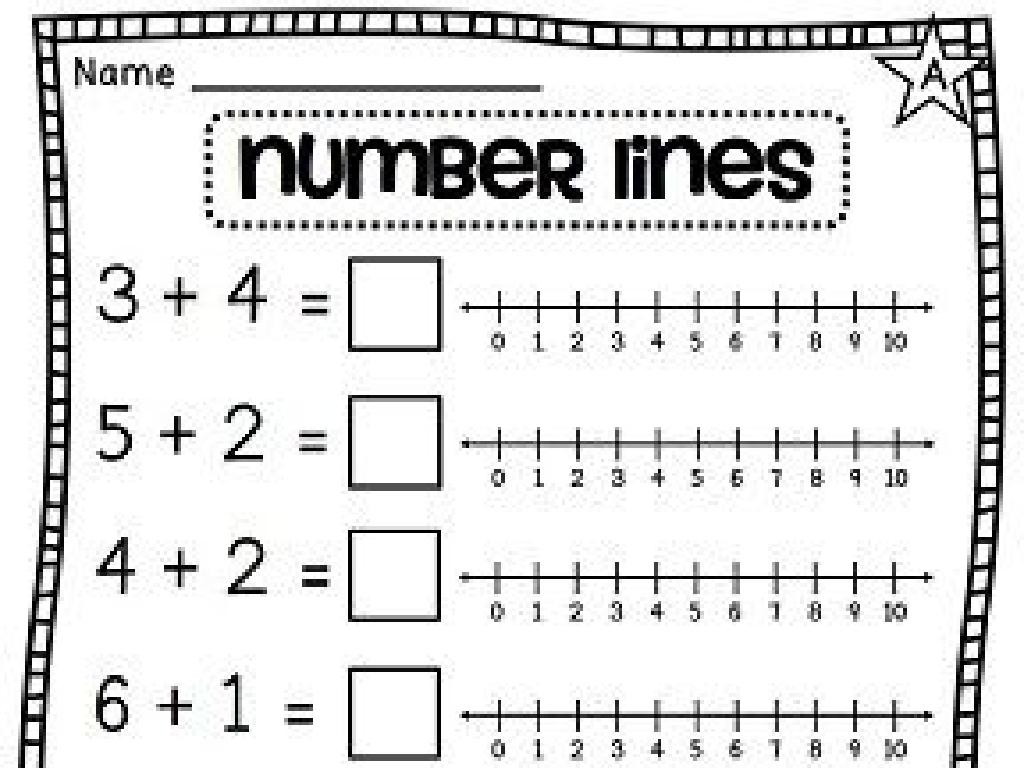Find The Slope From A Graph
Subject: Math
Grade: Eighth grade
Topic: Slope
Please LOG IN to download the presentation. Access is available to registered users only.
View More Content
Welcome to Slope: Understanding its Significance
– Defining slope in mathematics
– Slope measures steepness or incline of a line
– Slope in the real world
– Slope can represent things like speed or growth
– Calculating slope from a graph
– Use rise over run between two points on a line
– Significance of slope in math
|
This slide introduces the concept of slope, which is a fundamental aspect of algebra and geometry. Begin by defining slope as the measure of the steepness or incline of a line, often expressed as ‘rise over run.’ Highlight how slope is not just a mathematical concept but is also observed in everyday life, such as in the steepness of a hill or the rate of change in various situations like speed or economic growth. Teach students how to calculate the slope from a graph by identifying two points and using the formula (change in y)/(change in x). Emphasize the importance of understanding slope as it is crucial for solving real-world problems involving rates of change and for understanding other advanced mathematical concepts.
Understanding Graphs: The Basics
– Review the coordinate plane
– A flat surface with horizontal and vertical lines where we plot numbers
– Learn about X-axis and Y-axis
– Horizontal line (X-axis) and vertical line (Y-axis) intersect at the origin
– How to plot points
– Each point is defined by an (x, y) pair showing its position
– Graphs represent data visually
|
Begin with a review of the coordinate plane, ensuring students recall how to identify the horizontal (X-axis) and vertical (Y-axis) axes. Emphasize the importance of the origin (0,0) where both axes intersect. Demonstrate how to plot points on the graph by identifying the x and y coordinates and marking the corresponding point on the plane. Explain that graphs are a way to visually represent data, making it easier to understand and interpret. Use examples relevant to their experiences, such as plotting points for a game or tracking daily temperatures. This foundational knowledge is crucial for understanding how to find the slope from a graph, which will be covered in subsequent slides.
Understanding Slope in Graphs
– Slope: ‘Rise over Run’
– Slope measures steepness: vertical change (rise) over horizontal change (run).
– Positive vs Negative Slope
– Positive slope: rises to the right. Negative slope: falls to the right.
– Zero Slope explained
– Zero slope: a flat, horizontal line. No rise or fall.
– Undefined Slope concept
– Undefined slope: a vertical line. Infinite rise, no run.
|
This slide introduces the concept of slope, which is a fundamental aspect of algebra and coordinate geometry. Slope is the measure of the steepness of a line, calculated as the ratio of the vertical change (rise) to the horizontal change (run) between two points on the line. Positive slopes indicate an upward trend as one moves from left to right, while negative slopes indicate a downward trend. A zero slope means the line is horizontal and has no vertical change, while an undefined slope occurs with vertical lines where the horizontal change is zero. Encourage students to practice by drawing graphs and identifying the slope type. Provide examples of each slope type and ask students to come up with real-life scenarios where these slopes might be represented in a graph.
Calculating Slope from a Graph
– Identify two points on the line
– Count the vertical change (Rise)
– The ‘rise’ is the change in ‘y’ between two points
– Count the horizontal change (Run)
– The ‘run’ is the change in ‘x’ between two points
– Apply the slope formula
– Slope (m) = Rise/Run, a measure of steepness
|
This slide is aimed at teaching students how to calculate the slope of a line from a graph. Start by identifying any two points on the line. Then, count the vertical change, or ‘rise,’ which is the difference in the y-coordinates of the two points. Next, count the horizontal change, or ‘run,’ which is the difference in the x-coordinates. To find the slope, divide the rise by the run. The slope, denoted as ‘m,’ represents the steepness of the line. A positive slope means the line goes up from left to right, while a negative slope means it goes down. If the line is horizontal, the slope is 0, and if it’s vertical, the slope is undefined. Encourage students to practice with different lines on a graph to become comfortable with the concept.
Exploring Slopes on Graphs
– Slope of uphill lines
– Rise over run is positive for uphill
– Slope of downhill lines
– Rise over run is negative for downhill
– Horizontal lines have zero slope
– Horizontal line: no rise, slope is 0
– Vertical lines have undefined slope
– Vertical line: no run, slope is undefined
|
This slide aims to help students visualize and calculate the slope of different types of lines on a graph. Example 1 demonstrates how to find the slope of an uphill line, which will always be positive as the line rises from left to right. Example 2 shows that downhill lines have a negative slope because they fall as they move from left to right. Example 3 explains that horizontal lines have a zero slope because there is no rise; the line is flat. Example 4 clarifies that vertical lines have an undefined slope due to the division by zero scenario (no horizontal change). Encourage students to practice by drawing their own lines and calculating the slope to reinforce these concepts.
Practice Problems: Finding the Slope
– Practice Problem 1: Find the slope
– Use the graph to determine rise over run
– Practice Problem 2: Find the slope
– Use the graph to determine rise over run
– Practice Problem 3: Find the slope
– Use the graph to determine rise over run
– Discuss solutions and methods
|
This slide is dedicated to hands-on practice for students to apply their knowledge of finding the slope from a graph. Each practice problem will present a different line on a graph, and students will calculate the slope by identifying the rise over the run between two points on the line. Encourage students to work through these problems individually or in pairs, and then discuss the solutions as a class. Emphasize the importance of practice in mastering the concept of slope. Possible activities include having students come to the board to demonstrate their approach, peer teaching, or creating a gallery walk where students can see and discuss each other’s work.
Class Activity: Create Your Own Slope Story
– Students draw a graph with a line
– Invent a story explaining the line’s slope
– Could be about climbing a hill or the stock market
– Share your slope story with the class
– Discuss the variety of slopes and stories
– Understand how different slopes represent different scenarios
|
This activity is designed to help students understand the concept of slope in a fun and creative way. By drawing their own graphs and coming up with stories that correlate with the slope of the line, students will be able to visualize and better grasp the concept of slope. Encourage them to think outside the box; their stories could involve anything from hiking up a mountain to the rise and fall of a roller coaster. After sharing, lead a discussion on how different stories represented the slopes on their graphs. This will also help students understand positive, negative, zero, and undefined slopes in a real-world context. Possible activities could include drawing slopes of famous mountains, graphing the progress of a character in a story, or charting the rise and fall of a business in a student-created narrative.
Wrapping Up: Slope & Homework Assignment
– Review key slope concepts
– Emphasize the value of practice
– Homework: Textbook graph problems
– Solve problems 1-10, finding slopes from graphs
– Be prepared to discuss solutions
– We’ll review these problems in our next class
|
This slide aims to consolidate the students’ understanding of slope by summarizing the main points covered in the lesson. Emphasize the importance of practice in mastering the concept of slope. For homework, students are assigned to find the slopes from graphs for problems 1-10 in their textbook. This will help reinforce their learning and provide an opportunity to apply the concepts independently. In the next class, be ready to discuss the solutions and clarify any doubts. Encourage students to try their best and remind them that making mistakes is a part of the learning process.






